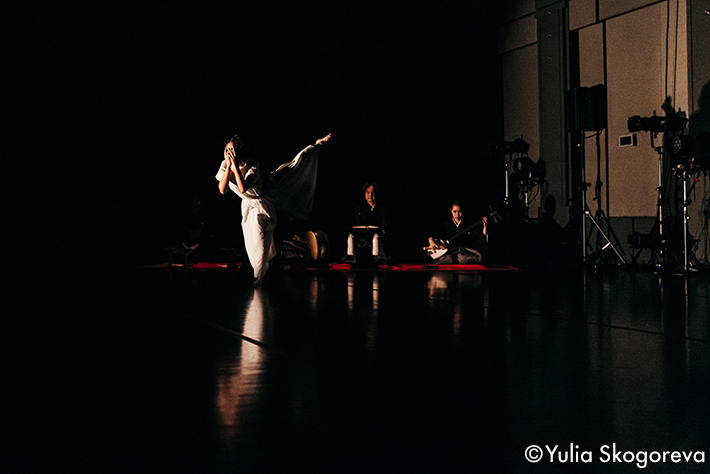
Yae Yamamichi × Megumi Abe
“Dance: Orochi -the myth of Great Serpent- Retold”
(Oct. 2020 at Spiral Hall)
Photo: Yulia Skogoreva
Fusion of Original Gidayu and Dance
Yae Yamamichi connects classic and modern
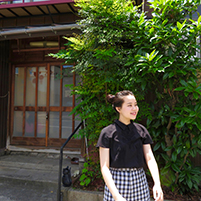
Yae Yamamichi (born in 1995) became familiar with Kabuki and Bunraku in childhood, she learned the Gidayu shamisen (the 3-stringed Japanese lute) from the age of six and traditional Japanese shamisen from the age of 10, and she is currently active as a composer and Futozao shamisen performer. Yamamichi has collaborated with contemporary dancers of her generation to present original Gidayu performances based on traditional Japanese works. She is attracting attention as an artist who connects the traditional and the modern with her young sensibilities.

Yae Yamamichi × Megumi Abe
“Dance: Orochi -the myth of Great Serpent- Retold”
(Oct. 2020 at Spiral Hall)
Photo: Yulia Skogoreva
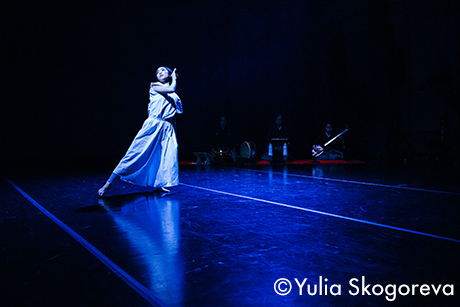
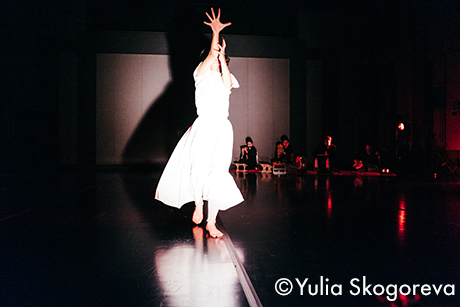
Yae Yamamichi × Megumi Abe
“Dance: Orochi -the myth of Great Serpent- Retold”
(Oct. 2020 at Spiral Hall)
Photo: Yulia Skogoreva

Roma Hashimoto x Yae Yamamichi
ENIGMA
(Dec. 2021 at KAAT Kanagawa Arts Theatre-Large Studio)
Photo: Yulia Skogoreva
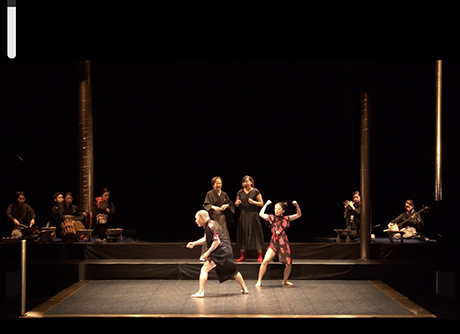
Kitamari/KIKIKIKIKIKI
Roka Yasou (Nocturne for the Old Flower)
(Oct. 2021 at Tokyo Metropolitan Theatre-Theatre West)
*1 Yoshitsune Senbonzakura (Yoshitsune and the Thousand Cherry Trees)
This is one of the Ningyo Jōruri (traditional Japanese puppet theater with narrative recitation and shamisen accompaniment, a forerunner of Bunraku) and Kabuki works. It is set against the backdrop of a six-year civil war at the end of the Heian period, commonly known as the Gempei Gassen (Gempei Wars, in which a samurai group led by Minamoto no Yoritomo overthrew the Taira clan government led by Taira Kiyomori). Yoshitsune Senbonzakura (Yoshitsune and the Thousand Cherry Trees) is a later story in which Yoshitsune, who was credited with military successes in the Gempei Wars, after fleeing the capital because of being suspected of rebellion by his brother Yoritomo, and the warlord of the Heike family, it turns out that the supposedly dead Yoshitsune, is alive and plotting revenge. At the Kawatsura Hogen Yakata, Yoshitsune, who is hidden in the hall, is visited by his concubine Shizuka Gozen with the Hatsune drum given to her by Yoshitsune as a token through his family member Tadanobu Sato (an incarnation of a child fox whose parents were made into the drum skin). There are many devices such as quick changes and suspended flights, and the highlight is when the fox, Tadanobu, reveals his identity.
*2 Sagi Musume (The Heron Maiden)
This is one of the well-known pieces of Kabuki and traditional Japanese dance (Nihon Buyo). It is a dance that compares the figure of a maiden who is burning with love to the appearance of a white heron. A white heron spirit first appears in a snowy landscape and then transforms into a maiden whose dance expresses the thoughts that possess her and then transforms once again into a white heron, falls into hell because of her obsessive love, and is tortured by a sense of blame.
*3 Imoseyama Onna Teikin (Mt Imo and Mt Se: A Tale of Womanly Virtue)
One of the Japanese puppet jōruri and Kabuki performances. Jidaimono written by Hanji Chikamatsu in the mid-Edo period (a work that deals with historical incidents and people using a period setting before the Edo period). Set in the political upheaval of an ancient dynasty, it depicts the fate of various loves born between them by weaving in a number of legends. One of those loves is the unrequited love of Omiwa, the daughter of a liquor store, who falls in love with Fujiwara Tankai, who was doing it to defeat her nemesis, and goes crazy with jealousy. However, he is told that the living blood of a jealous woman will help him defeat his nemesis, and he dies hoping that he will be united in the other world.
*4 Yamata no Orochi (Eight-headed Giant Snake)
A giant monster (large serpent) with eight heads and eight tails appears in Japanese mythology. Once a year, he appears and eats his daughter, so he is exterminated by Susanoo-no-Mikoto.
*5 Anchin Kiyohime Densetsu (The Story of Anchin and Kiyohime)
Kiyohime falls in love with the mountain priest Anchin, who rented a room at an inn for the night while on a pilgrimage to Kumano Gongen. Anchin escapes, but Kiyohime follows him by transforming into a large snake with tremendous tenacity. After escaping to Dojoji, Anchin, is hidden in temple bell, but Kiyohime, in her new form as a large snake, wraps herself around the bell and burns Anchin and the others with her flames.
*6 Musume Dojoji (The Maiden at Dojoji Temple)
One of the Kabuki dance performances. A later story of the legend of Anchin and Kiyohime. A memorial service is held for the new temple bell dedicated to Dojoji Temple, and a beautiful shirabyoshi (traditional Japanese dancer), who is an the incarnation of Kiyohime that appears and dances in various ways, and finally dances in the body of a snake.
*7 Aimyon
Born in 1995. A new generation of singer-songwriter who has become an icon for many young people with her strong lyrics and pop songs that describe wavering feelings with the sensibilities of the present times.
*8 Funa Benkei (Benkei and the Boat)
Based on the Noh play Funa Benkei (Benkei and the Boat), it was made into a Kabuki play, and then into a dance. The main characters are Taira no Tomomori, who became a vengeful ghost after death, and Shizuka Gozen, the mistress who was abandoned by his nemesis, Minamoto no Yoshitsune.
*9 Shunkan
After being exiled to the island called Kikaiga-shima because of an attempted coup d’état to depose the Heike (House of Taira), the priest Shukan is not released even in a general amnesty and is left alone in exile on the island.
*10 Hashihime
One of the tales of women, demons, and goddesses that appear in Japanese folklore related to bridges. In the Heike Tsurugi no maki (Heike Sword Scroll) of The Heike Monogatari (The Tale of Heike), this character is depicted as a demon mad with jealousy and becomes the prototype of the later story of Hashihime. In the Noh play Kanawa (Iron Trivet), Hashihime is portrayed as a demon woman crazed with jealously after losing her husband to his second wife.
*11 Roka Yasou (Nocturne for the Old Flower)
Written in 1974. At Hotel Gekko, men come each night in search of prostitutes. It was said that “on the night of a lunar eclipse, prostitutes quietly wash their feet after finishing their last duties,” but Hana, an old prostitute who has not been able to get customers for another month, shows no signs of stopping. While indulging in memories of the men she had known, Hana has been waiting for a long time for a certain man to come again.
*12 The Kuma Foundation
Founded by Naruatsu Baba, Chairman and Chief Creator of COLOPL Co., Ltd., which develops and distributes popular games for smartphones. The foundation supports student creators under the age of 25 with scholarships (grant-type, free use, 1.2 million yen per year, to 50 people), and also supports the growth and activities of creators by providing creator scholarships for creators, activity support projects for scholarship students and graduates (300,000 yen to 5 million yen per year) and providing a place for creators to connect.
Related Tags